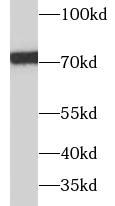Products
RPA1 antibody
Category:
Research Area:
- SPECIFICATIONS
- Product Name
- RPA1 antibody
- Catalogue No.
- FNab07391
- Size
- 100μg
- Form
- liquid
- Purification
- Immunogen affinity purified
- Purity
- ≥95% as determined by SDS-PAGE
- Clonality
- polyclonal
- Isotype
- IgG
- Storage
- PBS with 0.02% sodium azide and 50% glycerol pH 7.3, -20℃ for 12 months(Avoid repeated freeze / thaw cycles.)
Immunogen
- Immunogen
- replication protein A1, 70kDa
- Alternative Names
- HSSB antibody, MST075 antibody, REPA1 antibody, RF-A antibody, RP-A antibody, RPA70 antibody
- UniProt ID
- P27694
- Observed MW
- 70kDa
Application
- Tested Applications
- ELISA, WB
- Recommended dilution
- WB: 1:500 - 1:2000
Validated Images
 Hela cells were subjected to SDS PAGE followed by western blot with FNab07391(RPA1 antibody) at dilution of 1:1000
Hela cells were subjected to SDS PAGE followed by western blot with FNab07391(RPA1 antibody) at dilution of 1:1000
- Background
- As part of the heterotrimeric replication protein A complex(RPA/RP-A), binds and stabilizes single-stranded DNA intermediates, that form during DNA replication or upon DNA stress. It prevents their reannealing and in parallel, recruits and activates different proteins and complexes involved in DNA metabolism. Thereby, it plays an essential role both in DNA replication and the cellular response to DNA damage(PubMed:9430682). In the cellular response to DNA damage, the RPA complex controls DNA repair and DNA damage checkpoint activation. Through recruitment of ATRIP activates the ATR kinase a master regulator of the DNA damage response(PubMed:24332808). It is required for the recruitment of the DNA double-strand break repair factors RAD51 and RAD52 to chromatin in response to DNA damage(PubMed:17765923). Also recruits to sites of DNA damage proteins like XPA and XPG that are involved in nucleotide excision repair and is required for this mechanism of DNA repair(PubMed:7697716). Plays also a role in base excision repair(BER) probably through interaction with UNG(PubMed:9765279). Through RFWD3 may activate CHEK1 and play a role in replication checkpoint control. Also recruits SMARCAL1/HARP, which is involved in replication fork restart, to sites of DNA damage. May also play a role in telomere maintenance(PubMed:17959650). As part of the alternative replication protein A complex, aRPA, binds single-stranded DNA and probably plays a role in DNA repair. Compared to the RPA2-containing, canonical RPA complex, may not support chromosomal DNA replication and cell cycle progression through S-phase. The aRPA may not promote efficient priming by DNA polymerase alpha but could support DNA synthesis by polymerase delta in presence of PCNA and replication factor C(RFC), the dual incision/excision reaction of nucleotide excision repair and RAD51-dependent strand exchange(PubMed:19996105).



